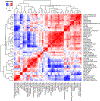CT Radiomic Features for Predicting Resectability and TNM Staging in Thymic Epithelial Tumors
- PMID: 33844992
- PMCID: PMC9475805
- DOI: 10.1016/j.athoracsur.2021.03.084
CT Radiomic Features for Predicting Resectability and TNM Staging in Thymic Epithelial Tumors
Abstract
Background: To explore the performance of a computed tomography based radiomics model in the preoperative prediction of resectability status and TNM staging in thymic epithelial tumors.
Methods: We reviewed the last preoperative computed tomography scan of patients with thymic epithelial tumors prior to resection and pathology evaluation at our institution between February 2008 and June 2019. A total of 101 quantitative features were extracted and a radiomics model was trained using elastic net penalized logistic regressions for each aim. In the set-aside testing sets, discriminating performance of each model was assessed with area under receiver operating characteristic curve.
Results: Our final population consisted of 243 patients with: 153 (87%) thymomas, 23 (9%) thymic carcinomas, and 9 (4%) thymic carcinoids. Incomplete resections (R1 or R2) occurred in 38 (16%) patients, and 67 (28%) patients had more advanced stage tumors (stage III or IV). In the set-aside testing sets, the radiomics model achieved good performance in preoperatively predicting incomplete resections (area under receiver operating characteristic curve: 0.80) and advanced stage tumors (area under receiver operating characteristic curve: 0.70).
Conclusions: Our computed tomography radiomics model achieved good performance to predict resectability status and staging in thymic epithelial tumors, suggesting a potential value for the evaluation of radiomic features in the preoperative prediction of surgical outcomes in thymic malignancies.
Copyright © 2022 The Society of Thoracic Surgeons. Published by Elsevier Inc. All rights reserved.
Figures






Similar articles
-
Computed tomography radiomic feature analysis of thymic epithelial tumors: Differentiation of thymic epithelial tumors from thymic cysts and prediction of histological subtypes.Jpn J Radiol. 2024 Apr;42(4):367-373. doi: 10.1007/s11604-023-01512-0. Epub 2023 Nov 27. Jpn J Radiol. 2024. PMID: 38010596
-
MRI Radiomics Analysis for Predicting the Pathologic Classification and TNM Staging of Thymic Epithelial Tumors: A Pilot Study.AJR Am J Roentgenol. 2020 Feb;214(2):328-340. doi: 10.2214/AJR.19.21696. Epub 2019 Dec 4. AJR Am J Roentgenol. 2020. PMID: 31799873
-
Comparison of 2D and 3D radiomics features with conventional features based on contrast-enhanced CT images for preoperative prediction the risk of thymic epithelial tumors.Radiol Oncol. 2025 Feb 27;59(1):69-78. doi: 10.2478/raon-2025-0016. eCollection 2025 Mar 1. Radiol Oncol. 2025. PMID: 40014788 Free PMC article.
-
Prediction of thymoma histology and stage by radiographic criteria.Thorac Surg Clin. 2011 Feb;21(1):1-12, v. doi: 10.1016/j.thorsurg.2010.08.008. Thorac Surg Clin. 2011. PMID: 21070982 Review.
-
Is a positron emission tomography-computed tomography scan useful in the staging of thymic epithelial neoplasms?Interact Cardiovasc Thorac Surg. 2014 Jul;19(1):129-34. doi: 10.1093/icvts/ivu068. Epub 2014 Mar 19. Interact Cardiovasc Thorac Surg. 2014. PMID: 24648467 Review.
Cited by
-
Radiomics in thymic epithelial tumors: a scoping review of current status and advances.BMC Cancer. 2025 Mar 17;25(1):493. doi: 10.1186/s12885-025-13909-3. BMC Cancer. 2025. PMID: 40098112 Free PMC article.
-
Conventional and radiomic features to predict pathology in the preoperative assessment of anterior mediastinal masses.Lung Cancer. 2023 Apr;178:206-212. doi: 10.1016/j.lungcan.2023.02.014. Epub 2023 Feb 21. Lung Cancer. 2023. PMID: 36871345 Free PMC article.
-
Current Treatment Approaches for Thymic Epithelial Tumors.Life (Basel). 2023 May 12;13(5):1170. doi: 10.3390/life13051170. Life (Basel). 2023. PMID: 37240815 Free PMC article. Review.
-
Computed tomography-based radiomic to predict resectability in locally advanced pancreatic cancer treated with chemotherapy and radiotherapy.World J Gastrointest Oncol. 2022 Mar 15;14(3):703-715. doi: 10.4251/wjgo.v14.i3.703. World J Gastrointest Oncol. 2022. PMID: 35321278 Free PMC article.
-
Machine learning models from computed tomography to diagnose thymic epithelial tumors requiring combined resection.J Thorac Dis. 2024 Aug 31;16(8):4935-4946. doi: 10.21037/jtd-23-1840. Epub 2024 Aug 15. J Thorac Dis. 2024. PMID: 39268145 Free PMC article.
References
-
- Regnard J-F, Magdeleinat P, Dromer C, et al. Prognostic factors and long-term results after thymoma resection: A series of 307 patients. J Thorac Cardiovasc Surg. 1996;112(2):376–384. - PubMed
-
- Kondo K, Monden Y. Therapy for thymic epithelial tumors: a clinical study of 1,320 patients from Japan. The Annals of thoracic surgery. 2003;76(3):878–884; discussion 884–875. - PubMed
-
- Lardinois D, Rechsteiner R, Läng RH, et al. Prognostic relevance of Masaoka and Müller-Hermelink classification in patients with thymic tumors. The Annals of thoracic surgery. 2000;69(5):1550–1555. - PubMed
-
- Cardillo G, Carleo F, Giunti R, et al. Predictors of survival in patients with locally advanced thymoma and thymic carcinoma (Masaoka stages III and IVa). Eur J Cardiothorac Surg. 2010;37(4):819–823. - PubMed
MeSH terms
Supplementary concepts
Grants and funding
LinkOut - more resources
Full Text Sources
Other Literature Sources
Medical

